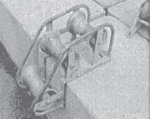Manual Handling of Loads. Cable laying
7. Cable laying
The operation of cable laying is one of the most common tasks carried out by the ISASTUR Group that exposes workers to possible muscular overstrain. For this reason, an analysis of the path of the cables is to be carried before laying them for:
- 1. The possible regrouping of lines.
- 2. The necessary measurements.
- 3. The possible use of mechanical means, such as a winch, for which it is mandatory to use pulling sleeves or heads, choosing the appropriate ones on the basis of the workload in kilograms and the diameter of the cable (the load is to be calculated by the weight of the cable and its length). If in doubt, consult the Works Supervisor.
- Said data is also to be taken into account to establish the number of workers needed to perform the task of hanging the cable.
- 4. Assessing the means to employ, such as an elevating platform, scaffolding, etc., if the work is at a height.
- 5. Providing personnel with the most suitable works means to minimize muscular overstrain.
- 6. The best possible placement of spools, as this will facilitate work.
- 7. Establishing whether the lighting for the job is adequate in its entire length so as to assess the need for placing additional lighting.
7.1. Laying
The work area is to be duly signposted and demarcated using tape and/or plastic chains supported by posts or the like. Monitor, check and maintain this signposting and cordon.
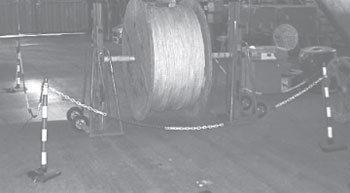
|
Work area demarcated and signposted so as to impede access by workers unrelated to the job. |
When laying cable, the minimum radius of curvature specified by the manufacturer is to be taken into account.
If the tray already has cables, these are to be protected against possible scratches that may leave the cores bare.
When the spools are very large and heavy, jack stands with a braking mechanism are to be used to prevent the runaway of the spool.
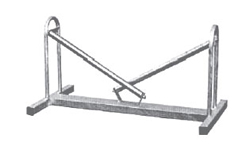
|
 |
| V-guide rollers | 7-ton jack stand with braking mechanism |
| This roller (V-guide) is employed at the spool output so as to substantially improve the guiding of the cable. It prevents the cable from rubbing against surfaces that can damage it and the centring effect is produced both easily and safely. | |
Suitable slings are to be used to lift and move spools, following the manufacturer’s instructions.
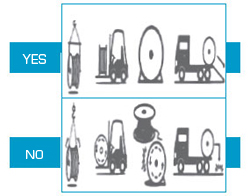
|
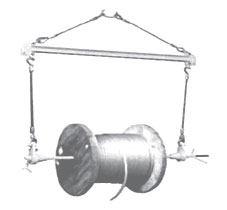 |
| Using suitable slings avoids breakage of the wooden framework. | |
Do not stand within the radius of action of spools to avoid the possibly of being hit or trapped.
Special attention is to be paid to the possibility of hands and arms becoming trapped during cable laying and handling by the trays.
Likewise, a suitable communication system is to be established to coordinate orders (the use of transmitters may be necessary). Inadequate communication can result in situations of risk with the possibility of causing an accident.
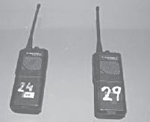
When the work requires uncomfortable positions, this is to be taken into account to give adequate breaks to avoid musculoskeletal overstrain.
Establish what amount and type of cable-laying rollers are to be used.
Curb-saving roller model.
